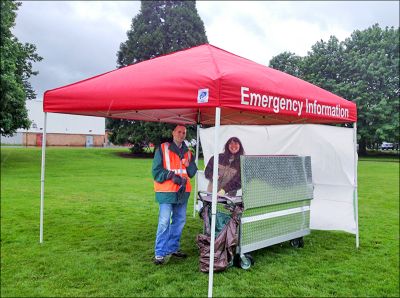BEECN Sites: Difference between revisions
Jump to navigation
Jump to search
mNo edit summary |
|||
| Line 24: | Line 24: | ||
# Though moving a BEECN site should be avoided, PBEM will consider moving a site if a more appropriate one is found in the immediate neighborhood of the BEECN. | # Though moving a BEECN site should be avoided, PBEM will consider moving a site if a more appropriate one is found in the immediate neighborhood of the BEECN. | ||
=== BEECN Site | === BEECN Site criteria === | ||
The ideal BEECN Site is: | The ideal BEECN Site is: | ||
* An open area large enough to hold a crowd of at least 100 people; | * An open area large enough to hold a crowd of at least 100 people; | ||
Revision as of 15:04, 10 January 2025
| BEECN Guidelines ↱ |
| Introduction |
| BEECN Program Organization |
| BEECN Sites |
| BEECN Volunteers |
| BEECN Caches |
| Operations at BEECN Sites |
The BEECN Site is the geographic location intended to serve as a gathering point for persons looking for help in the aftermath of an earthquake. A BEECN Site is public information, published on maps, and Portlanders are encouraged to know where their nearest BEECN Site is.
Location of BEECN Sites

- At minimum, there will be a total of 48 BEECN sites located throughout the City of Portland.
- BEECNs will be evenly distributed throughout the city and are generally sited with the goal of placing approximately two BEECNs within each of the Portland Plan’s neighborhood hub boundaries (see Appendix B).
- PBEM has complete discretion over the location of each BEECN site. However, PBEM will consider the input of property owners, community partners, city employees, and volunteers when deciding BEECN site locations.
- Though moving a BEECN site should be avoided, PBEM will consider moving a site if a more appropriate one is found in the immediate neighborhood of the BEECN.
BEECN Site criteria
The ideal BEECN Site is:
- An open area large enough to hold a crowd of at least 100 people;
- A safe distance from unreinforced masonry structures (such as older brick structures);
- Is not on a steep gradient or near landslide hazards, and not easily subject to flooding;
- Is not in the vicinity of tall trees, overhead power lines, or other utility hazards;
- Is familiar to the community and following a disaster might be intuited by neighbors as a community gathering point, and is geographically central to the immediate community.
What a BEECN Site is not
A BEECN Site is...
- ...not necessarily the same location where the BEECN Cache is stored;
- ...not a designated medical care point, though it is possible it may serve as one after the earthquake;
- ...not a location designated for post-disaster supply distribution, though it may serve that purpose after an earthquake.